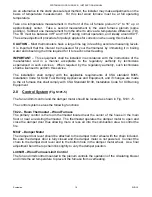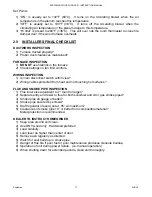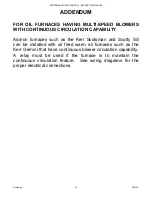
SCOTSMAN WOOD FURNACE – INSTRUCTION MANUAL
Scotsman
Jun
-10
15
The furnace must not be installed as a gravity system as the controls are not designed for this
type of operation.
The dimensions and locations of permissible openings in casings for ducts, blower, or
emergency air are clearly identified on the furnace or on specific templates enclosed in the
firebox.
DO NOT
use duct elbows having an inside radius of less than 6 in (155mm). Use only 16 x 20
in. duct “S” type interconnection for this furnace.
Make or enlarge the openings in the wood furnace casing exactly as identified for add-on
connection and on the appropriate side, trim the furnace insulation flush with cut opening.
Fasten edges of insulation securely with metal straps or bend tabs of duct starting collar over
insulation edge to hold it in place.
Make all duct connections for the “S” type interconnection, see Fig. S101-5.
CAUTION
-
The DB-101 Add-On is
NOT
certified for installations using a divider in the plenum
of the oil furnace. An Add-On unit must only be connected to a furnace, duct system and
chimney, which are in good operating condition.
DO NOT
relocate any of the safety controls in
the original furnace installation. Operate the oil-fired unit periodically to ensure that it will
operate satisfactorily when needed.
DO NOT
connect to duct work so that a reverse flow is possible. Before attempting
installation, determine if there is suitable space available in the furnace area for the furnace
connection outlined herein.
The external static pressure in the warm air duct to the house of the original system must be
measured prior to any changes to the system. These are to be reset to the same values after
the add-on procedure to maintain airflow through the oil furnace.
An important requirement of this type of installation is that when installed in an existing system
the main ducts may have to be lowered to assure proper and safe clearances from
combustible material. See Fig. S101-1.
After all connections are made a static pressure test and/or temperature measurement must
be made in the outlet plenum of the wood furnace. This is a simple procedure and is outlined
as follows using a Dwyer Model 25 or equal inclined manometer:
Drill hole in wood outlet plenum. Level inclined manometer and adjust to zero, insert
manometer tube (Pressure end). With all duct work and doors in place static pressure should
measure 0.2 in (50 Pa) with blower running.
Pressure may be corrected by the following measures:
1) Change blower pulley size (usually decrease)
2) Change blower motor pulley (usually increase)
3) Increase return air duct area (if restricted)
CAUTION
– Current draw by blower motor should be checked after making any pulley change.
If motor now draws greater current than that shown on the nameplate a larger more powerful
motor must be installed.
IMPORTANT
–
DO NOT
change the blower.






























